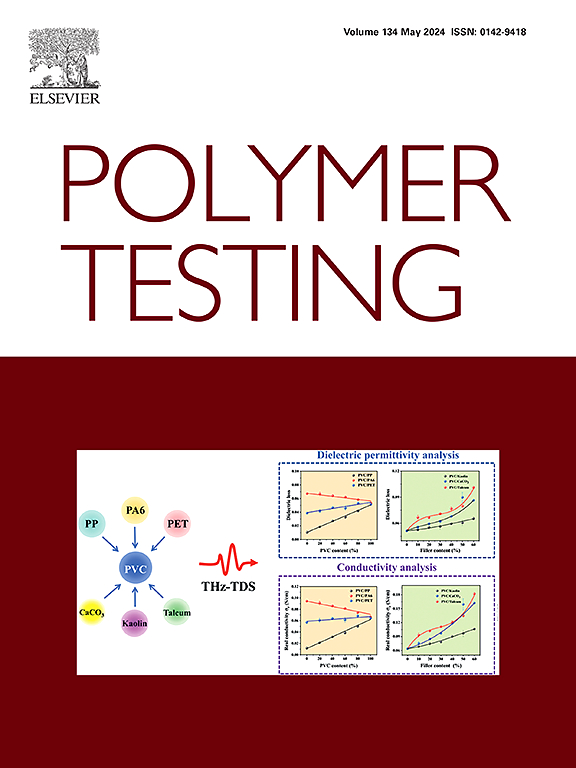聚乳酸与 ATBC 的二元材料以及 ATBC 与介孔 MCM-41 的复合材料中的中间相
IF 5
2区 材料科学
Q1 MATERIALS SCIENCE, CHARACTERIZATION & TESTING
引用次数: 0
摘要
为了克服聚乳酸结晶率低这一重要缺点,我们制备了几种富含 L 的聚乳酸(PLA)与柠檬酸三正丁酯(ATBC)以及美孚物质成分第 41 号(MCM-41)介孔颗粒的复合材料。为了解决这一缺陷,两个试样仅在室温下就自发形成了聚乳酸介相。这一发现是通过相应的 X 射线衍射图确定的,这些衍射图与拉伸实验所观察到的介相衍射图相似。正如 DSC 和实时变温同步辐射衍射实验所显示的那样,介相最初出现时,其再结晶成核能力明显高于无定形样品。此外,与晶体中约 16-18 纳米的长间距值相比,介相的长间距值相对较小,约为 10-11 纳米。另一方面,根据傅立叶变换红外光谱测量结果,介相在大多数情况下显示出介于无定形相和晶体相之间的有序度。它的最大特征是在 916 cm-1 处观察到一个独特的峰值,而晶体在 923 cm-1 处显示的是 α′ 相,在 921 cm-1 处显示的是 α 改性。光谱中低于 800 cm-1 左右的低频区域在文献中鲜有提及,但也被发现对有序性特别敏感。本文章由计算机程序翻译,如有差异,请以英文原文为准。
The mesophase of PLA in binary materials with ATBC and in composites with ATBC and mesoporous MCM-41
Several composites of an L-rich polylactide (PLA) with acetyl tri-n-butyl citrate (ATBC), and mesoporous particles of Mobil Composition of Matter No. 41 (MCM-41) have been prepared in order to overcome the important drawback of PLA related to its rather low crystallization rate. Additionally of solving that deficiency, the mesophase of PLA has been spontaneously formed in two specimens just by standing at room temperature. This finding was ascertained from the corresponding X-ray diffractograms, which are similar to those observed for the mesophase obtained by stretching experiments. When the mesophase is initially present, its nucleation ability for recrystallization is significantly higher than the one exhibited by amorphous samples, as shown by both DSC and real-time variable-temperature synchrotron diffraction experiments. Moreover, the mesophase displays relatively small values of the long spacing, around 10–11 nm, compared with the values of about 16–18 nm found in the crystals. On the other hand, the mesophase shows in most cases an intermediate degree of order between the amorphous and crystalline phases, as stated by FTIR measurements. Its most characteristic feature is the observation of a distinctive peak at 916 cm−1, while the crystals show a specific peak at 923 cm−1 for the α′ phase and at 921 cm−1 for the α modification. The low-frequency region of the spectra below around 800 cm−1, scarcely commented in literature, has also been found especially sensitive to ordering.
求助全文
通过发布文献求助,成功后即可免费获取论文全文。
去求助
来源期刊

Polymer Testing
工程技术-材料科学:表征与测试
CiteScore
10.70
自引率
5.90%
发文量
328
审稿时长
44 days
期刊介绍:
Polymer Testing focuses on the testing, analysis and characterization of polymer materials, including both synthetic and natural or biobased polymers. Novel testing methods and the testing of novel polymeric materials in bulk, solution and dispersion is covered. In addition, we welcome the submission of the testing of polymeric materials for a wide range of applications and industrial products as well as nanoscale characterization.
The scope includes but is not limited to the following main topics:
Novel testing methods and Chemical analysis
• mechanical, thermal, electrical, chemical, imaging, spectroscopy, scattering and rheology
Physical properties and behaviour of novel polymer systems
• nanoscale properties, morphology, transport properties
Degradation and recycling of polymeric materials when combined with novel testing or characterization methods
• degradation, biodegradation, ageing and fire retardancy
Modelling and Simulation work will be only considered when it is linked to new or previously published experimental results.
 求助内容:
求助内容: 应助结果提醒方式:
应助结果提醒方式:


